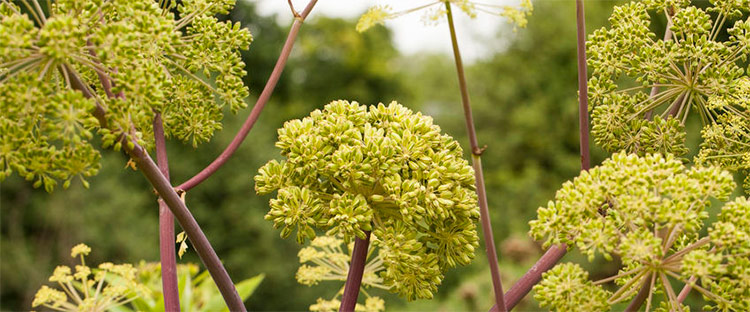Angelica Root Essential Oil
Angelica archangelica

Description
Here in the Midwest, I had grown Angelica for a couple seasons. Its height and distinctive appearance was a unique backdrop to my other herbs. It is the root that is most frequently used for its arsenal of therapeutic properties.
A number of sources indicate that Angelica Root Essential Oil may help fight infections, stimulate the immune system and help motivate the elimination of toxins.

Angelica Root Essential Oil also has a history of aromatherapy use towards combating stress, anxiety and exhaustion.
Aromatically, I find the aroma of Angelica Root Essential Oil to be pleasant. It is known for its use in perfumery and fragrancing. You will likely find Angelica Root Oil to be one that you don't prefer to use on its own, and will likely prefer to blend it with other oils. It's woody and peppery aroma blends well with wood oils like Cedarwood, Juniper Berry Essential Oil, some of the spice oils, and I also enjoy blending it with Orange or Bergamot Essential Oils.
Angelica Root is said to be a key ingredient in the flavoring of Benedictine and Chartreuse, both distinctively flavored liquors.
Angelica Root Essential Oil is a phototoxic oil. Several sources indicate that Angelica Root Oil contains bergapten, the same constituent that is responsible for the phototoxicity of Bergamot Essential Oil. (See below Safety Information section for more info).
Angelica Root Essential Oil Benefits and Uses
- Coughs
- Sinus Infections
- Arthritis
- Gout
- Fatigue
- Psoriasis
- Stress
- Quitting Smoking and Nicotine Addiction
References: Neryls Purchon and Lora Cantele, Complete Aromatherapy & Essential Oils Handbook for Everyday Wellness (Toronto ON: Robert Rose, 2014), 31. Julia Lawless, The Encyclopedia of Essential Oils (Updated Edition) (London: Harper Thorsons, 2014), 37-38. Jane Buckle, PhD, RN, Clinical Aromatherapy: Essential Oils in Healthcare (Third Edition. United Kingdom: Churchill Livingstone Elsevier, 2015), 290-293.
Botanical Name
Plant Family
Common Method of Extraction
Steam Distilled
Plant Part Typically Used
Root
(A seed oil is also available, but this profile is based on the root oil.)
Color
Pale Yellow
Consistency
Thin
Perfumery Note
Base
Strength of Initial Aroma
Medium - Strong
Aromatic Description
Angelica Root Essential Oil smells fresh, peppery, woody and herbaceous.
Major Constituents
- a-pinene
- Camphene
- B-pinene
- Sabinene
- d-3-carene,
- a-Phellandrene
- Myrcene
- Limonene
- B-phellandrene
- cis-Ocimene
- Trans-ocimene
- p-Cymene
- Terpinolene
- Copaene
- Bornyl
- acetate
- Terpinen-4-ol
- Cryptone
- B-bisabolene
- Humulene monoxide
- Tridecanolide
- Pentadecanolide
Source: B. Lawrence, "Angelica Root Oil," Perfumer & Flavorist, December/January 1977, 31, cited in Salvatore Battaglia, The Complete Guide to Aromatherapy (Australia: The Perfect Potion, 1997), 140.
Angelica Root Essential Oil Safety Information
Angelica Root Essential Oil is phototoxic. Although the steam distilled essential oil is preferred for holistic aromatherapy and is the basis for this profile, it's prudent to mention that Robert Tisserand and Rodney Young also mention that Angelica Root CO2 and Angelica Root Absolute are also possibly phototoxic. Reading Tisserand and Young's full profile is recommended. [Robert Tisserand and Rodney Young, Essential Oil Safety (Second Edition. United Kingdom: Churchill Livingstone Elsevier, 2014), 87.]
Avoid Angelica Root Oil during pregnancy and diabetes. [Julia Lawless, The Illustrated Encyclopedia of Essential Oils (Rockport, MA: Element Books, 1995), 84.]
Angelica Root CO2 Supercritical Select Extract
In addition to being available as an essential oil, this botanical is available from a small number of reputable sources as a CO2 extract. CO2 extracts offer many advantages. However, they can have differing safety precautions than essential oils because the natural chemistry of CO2 extracts can differ from their essential oil counterparts. Not much safety information is documented from trusted sources for CO2 extracts. Use CO2 extracts with great care and do not assume that every CO2 extract has the same safety precautions as its essential oil counterpart.
General Safety Information
Do not take any oils internally and do not apply undiluted essential oils, absolutes, CO2s or other concentrated essences onto the skin without advanced essential oil knowledge or consultation from a qualified aromatherapy practitioner. For general dilution information, read AromaWeb's Guide to Diluting Essential Oils. If you are pregnant, epileptic, have liver damage, have cancer, or have any other medical problem, use oils only under the proper guidance of a qualified aromatherapy practitioner. Use extreme caution when using oils with children and be sure to first read the recommended dilution ratios for children. Consult a qualified aromatherapy practitioner before using oils with children, the elderly, if you have medical issues or are taking medications. Before using this or any essential oil, carefully read AromaWeb's Essential Oil Safety Information page. For in-depth information on oil safety issues, read Essential Oil Safety by Robert Tisserand and Rodney Young.
Shelf Life
Important Information About the Profiles
The essential oil information provided on AromaWeb is intended for basic educational purposes only. The references to safety information, test results, constituents and percentages is generalized information. Essential oils can vary greatly in composition. The data is not necessary complete and is not guaranteed to be accurate. The essential oil photos are intended to represent the typical and approximate color of each essential oil. However, essential oil composition and color can vary based on harvesting, distillation, age of the essential oil and other factors. Profiles for several CO2 Extracts and absolutes are included within the directory, and are denoted as such.
